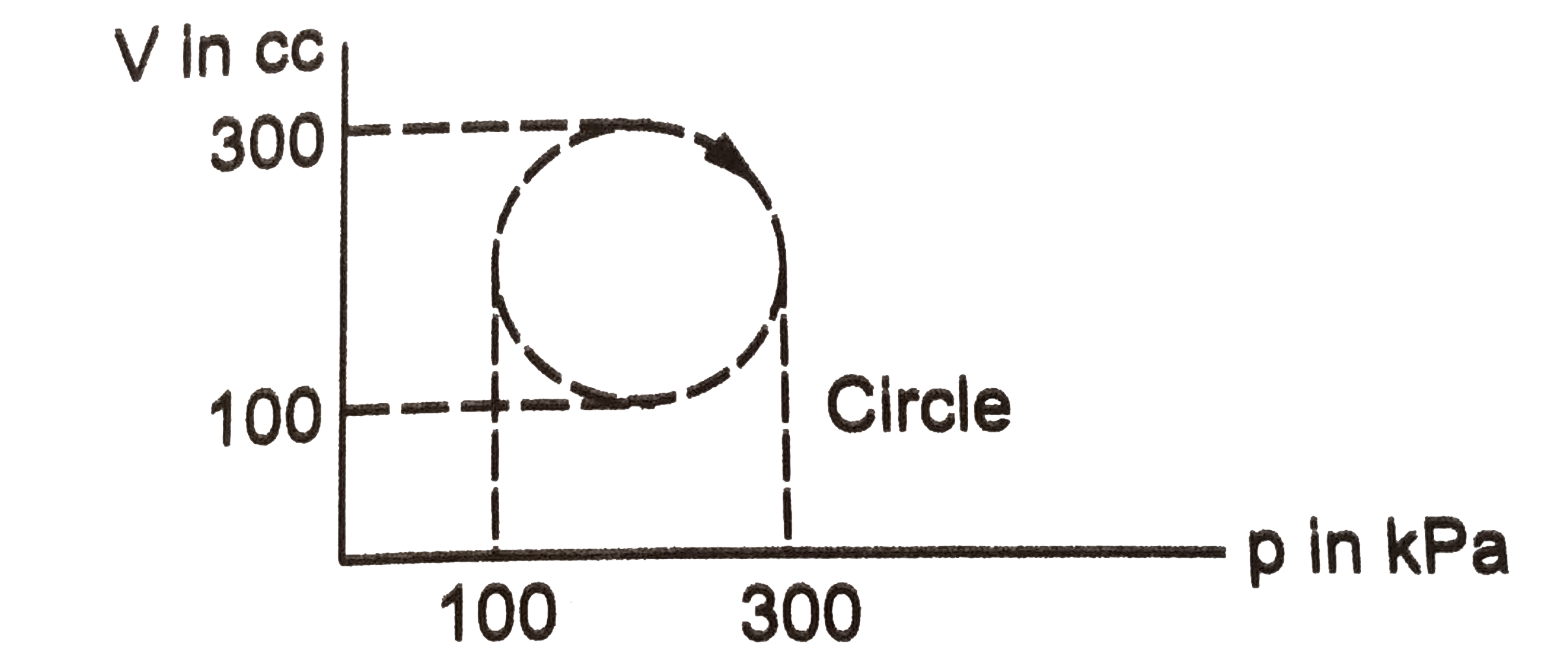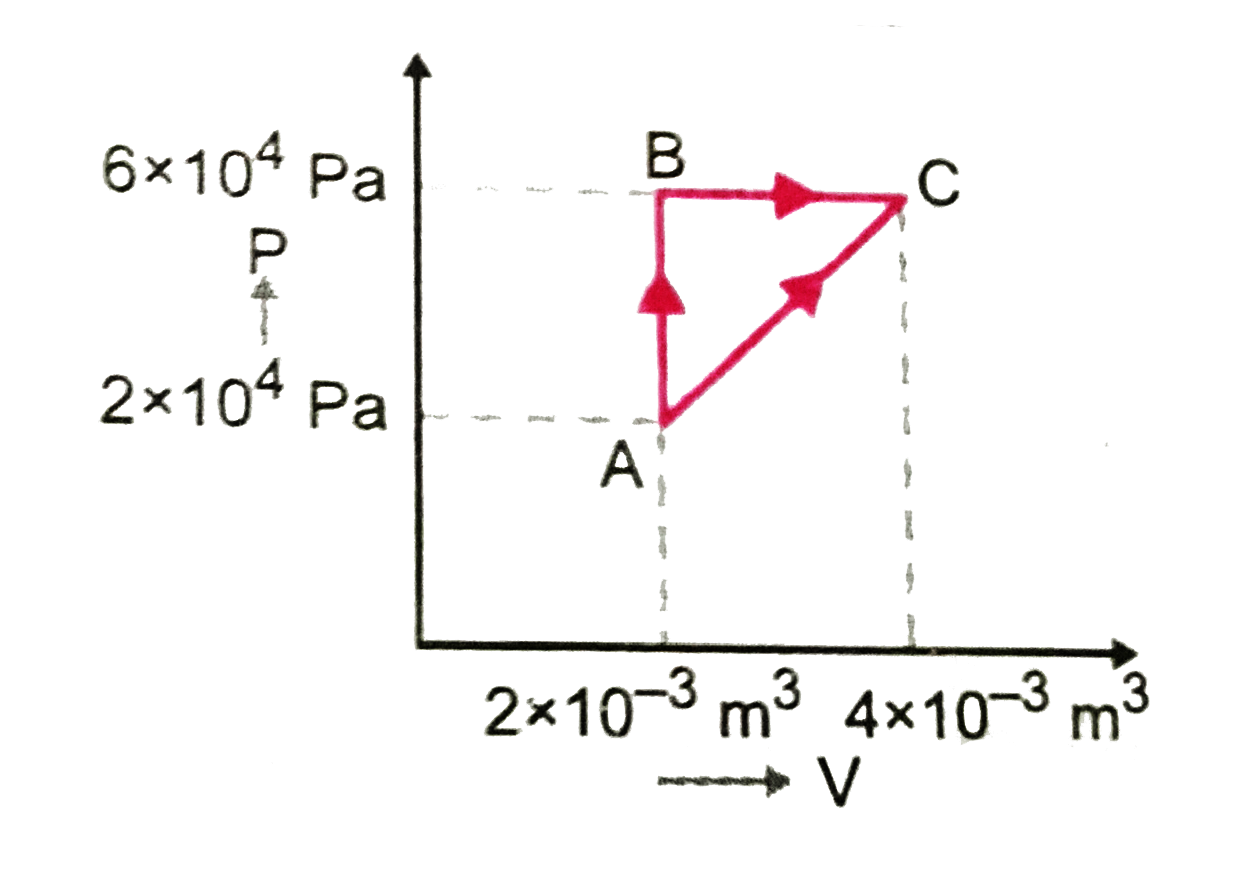What would be the heat absorbed by the system in the cyclic process?
−2PV
zero
2PV
PV
The correct Answer is:A
To solve the question regarding the heat absorbed by the system in a cyclic process, we can follow these steps:
1. Understanding the Cyclic Process:
In a cyclic process, the system returns to its initial state after completing a cycle. This means that all state functions, including internal energy (U), will have the same value at the beginning and end of the cycle.
Hint: Remember that in a cyclic process, the initial and final states are the same.
2. Change in Internal Energy (ΔU):
Since the internal energy of the system is a state function, the change in internal energy (ΔU) over one complete cycle is zero:
ΔU=0
Hint: State functions depend only on the current state, not on how the system got there.
3. First Law of Thermodynamics:
According to the first law of thermodynamics, the relationship between heat (Q), work (W), and internal energy (U) is given by:
ΔU=Q−W
Rearranging this gives:
Q=ΔU+W
Hint: The first law of thermodynamics relates heat, work, and internal energy.
4. Substituting ΔU:
Since we established that ΔU = 0 for a cyclic process, we can substitute this into the equation:
Q=0+W
Therefore, we have:
Q=W
Hint: If ΔU is zero, then all the heat absorbed is converted into work done.
5. Work Done in a Cyclic Process:
The work done (W) in a cyclic process can be represented by the area enclosed by the pressure-volume (PV) curve. For a given process, if the area under the curve is represented as pV, then:
W=pV
Hint: The area under the PV curve represents the work done during the process.
6. Conclusion:
Since we have established that the heat absorbed (Q) is equal to the work done (W), we can conclude that:
Q=pV
Therefore, the heat absorbed by the system in the cyclic process is pV.
Final Answer:
The heat absorbed by the system in the cyclic process is pV.
In a cyclic process, the system returns to its initial state after completing a cycle. This means that all state functions, including internal energy (U), will have the same value at the beginning and end of the cycle.
Since the internal energy of the system is a state function, the change in internal energy (ΔU) over one complete cycle is zero:
ΔU=0
According to the first law of thermodynamics, the relationship between heat (Q), work (W), and internal energy (U) is given by:
ΔU=Q−W
Rearranging this gives:
Q=ΔU+W
Since we established that ΔU = 0 for a cyclic process, we can substitute this into the equation:
Q=0+W
Therefore, we have:
Q=W
The work done (W) in a cyclic process can be represented by the area enclosed by the pressure-volume (PV) curve. For a given process, if the area under the curve is represented as pV, then:
W=pV
Since we have established that the heat absorbed (Q) is equal to the work done (W), we can conclude that:
Q=pV
Therefore, the heat absorbed by the system in the cyclic process is pV.
The heat absorbed by the system in the cyclic process is pV.
Topper's Solved these Questions
- THERMODYNAMICSBOOK - VMC MODULES ENGLISHCHAPTER - THERMODYNAMICSEXERCISE - LEVEL-2 (NUMERICAL VALUE TYPE)
15 Videos
- THERMODYNAMICSBOOK - VMC MODULES ENGLISHCHAPTER - THERMODYNAMICSEXERCISE - JEE (MAIN ARCHIVE)
32 Videos
- THERMODYNAMICSBOOK - VMC MODULES ENGLISHCHAPTER - THERMODYNAMICSEXERCISE - LEVEL-1
75 Videos
- THERMOCHEMISTRYBOOK - VMC MODULES ENGLISHCHAPTER - THERMOCHEMISTRYEXERCISE - JEE ADVANCED (ARCHIVE)
31 Videos
- THERMODYNAMICS & THERMOCHEMISTRYBOOK - VMC MODULES ENGLISHCHAPTER - THERMODYNAMICS & THERMOCHEMISTRYEXERCISE - Impeccable
48 Videos
Similar Questions
The state of a mole of an ideal gas changed from state A at pressure 2P and volume V follows four different processes and finally returns to initial state A reversibly as shown below in the graph. By interpreting the graph, answer the following questions.

What would be the heat obsorbed by the system in this cyclic process?
View SolutionDefine the Cyclic process.
View Solution
Knowledge Check
The heat absorbed by the system in going through the cyclic process as shown in figure is
 A30.4 JB31.4 JC32.4 JD33.4 J
A30.4 JB31.4 JC32.4 JD33.4 J
calculate the heat absorbed by a system in going through the cyclic process shown in ,

View SolutionIn (figure). shows two path that may be taken by a gas to go from a state A to state C

In the process AB, 400J of heat is added to the system and in process Bc, 100J of heat is added to the system. The heat absorbed by the system in the process AC will be
View SolutionCalculate the heat abosrbed by a system in going through the cyclic process show in Fig.

View SolutionCalculate the heat abosrbed by a system in going through the cyclic process show in Fig.

View SolutionFigure below shows two paths that may be taken by a gas to go from a state A to a state C . In process AB , 400 J of heat is added to the system and in process BC , 100 J of heat is added to the system . The heat absorbed by the system in the process AC will be

View Solution550kJcycle−1 work is done by 1 mol of an ideal gas in a cyclic process. The amount of heat absorbed by the system in one cycle is
View SolutionHeat energy absorbed by a system in going through a cyclic process shown in figure is

View Solution
